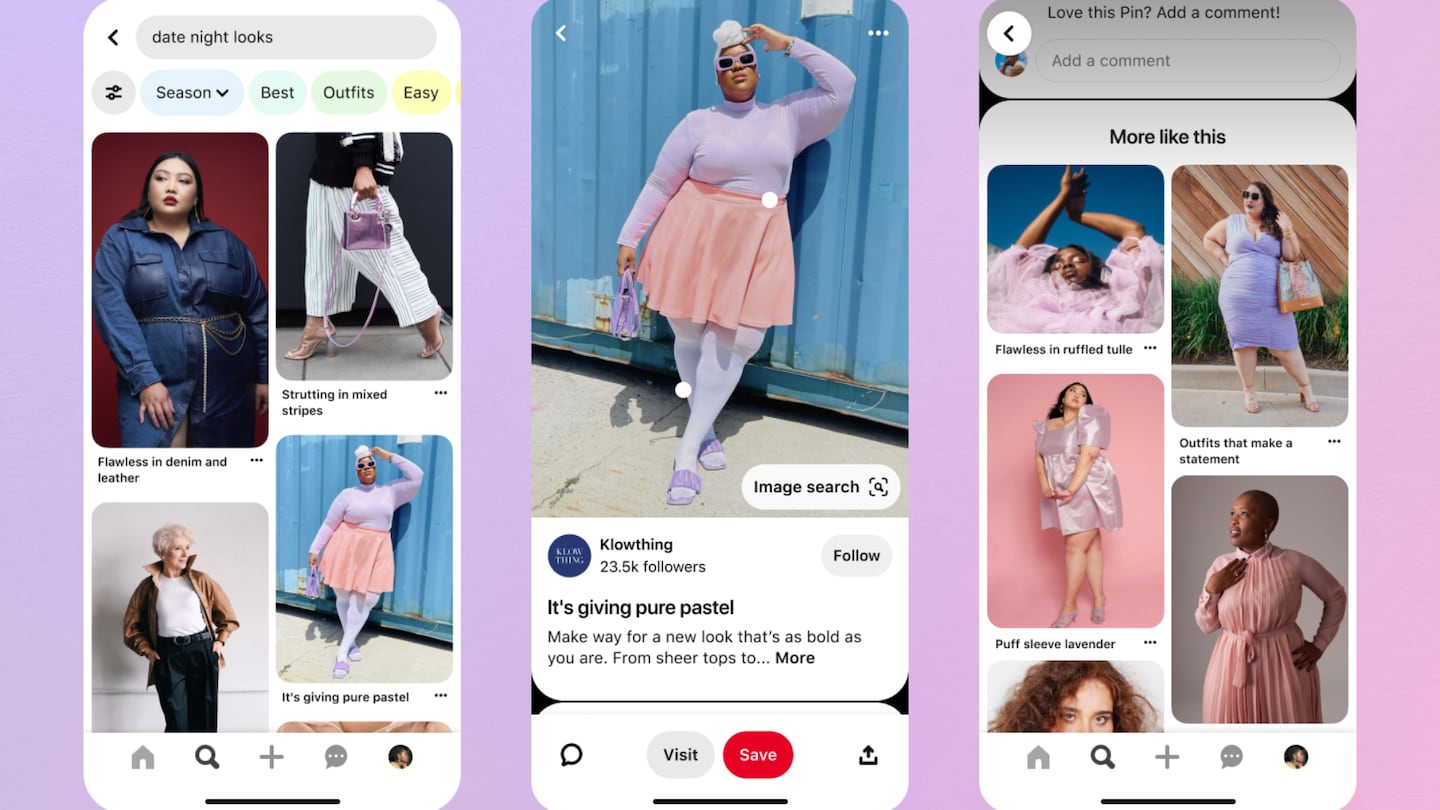
The Business of Fashion
Agenda-setting intelligence, analysis and advice for the global fashion community.

Agenda-setting intelligence, analysis and advice for the global fashion community.

As a source of inspiration for everything from hair styles to fashion, social media — like magazines before it — has served some users better than others. Marginalised groups haven’t always seen images of people with their features when searching for ideas online.
Pinterest, which built its base of nearly 500 million users largely as a place to find and save inspiration, sees artificial intelligence as at least a partial solution. The company introduced AI-powered filters for skin tone in 2018, allowing users to search for images of people with the same skin colour as them, along with one for body type last September. Pinterest also launched a separate filter for hair patterns in 2021 that lets users find images of people based on hair texture.
The features are popular. In 2023, searches using hair-pattern filters grew 41 percent year over year, and those using skin tone filters grew 51 percent.
“Our approach was really first to look at our most marginalised users, who were having to add a lot of qualifiers to find results that inspired them,” said Rachel Hardy, Pinterest’s director of consumer product marketing. “Every time you have to add a modifier about who you are, it’s painful and it’s not inspirational.”
ADVERTISEMENT
The company’s “inclusive AI” automates what would be a gruelling manual process of sifting through its catalogue of 5 billion images to serve user images of people with similar features. Pinterest also sees it as a way to help it build out its social commerce.
The personalisation it provides attracts more Gen-Z users, who have a higher expectation for personalised content and are spending more time on the platform than other groups. Since they’re finding the kind of inspirational content they want, they’re also more willing to click on tools like Pinterest’s shoppable “product pins,” which take users directly to a retailer’s site to buy.
Gen-Z consumers now account for more than 40 percent of monthly active users, Hardy said, and shopping behaviour among this group increased 50 percent year over year in 2023.
“These are the people that are our future audience. These are the people with the purchasing power,” Hardy said. “They are spending the most time on the platform. They’re saving the most. They’re buying more and more.”
For years, Pinterest was slower to push commerce on its platform, despite its purpose as an inspiration board easily translating to shopping, for fear of undermining the discovery-centric user experience, said Mark Mahaney, senior managing director of Evercore ISI. The company’s focus on commerce has ramped up since its chief executive Bill Ready took the helm in June 2022, including more tools for advertisers to drive sales like its direct links feature that was introduced in 2023 and takes users to advertisers’ product pages.
“[Pinterest] went from a hesitant or a tentative focus on e-commerce to a much more aggressive focus on e-commerce,” Mahaney said. Ready is “much more focused on treating advertisers and marketers almost as equal customers as users.”
Algorithmic recommendations can be a double-edged sword for social media companies pushing into commerce, however. Since TikTok introduced shopping, users have complained they’re constantly served content pushing products they don’t want instead of getting the entertaining videos they do.
When “social media uses AI, the algorithms are about understanding probability for engagement,” said Anabel Maldonado, founder and chief executive of software company Psykhe AI, which provides personalisation as a service to retailers. “When you introduce commerce, you’re now introducing a competing goal. These models that are showing commerce content need to be optimised for conversion.”
ADVERTISEMENT
Pinterest balances these competing goals by using AI to try to identify when users are in a purchasing versus a browsing mindset so it knows when to push shopping-oriented content. For users seeking inspiration, who will often type in generic terms like “summer cocktail dress vibes,” Pinterest will show generic images such as people in attractive frocks in the appropriate social setting. But users that search specific terms, such as “black Adidas in a size 7,” are served the product pins, which include the item’s price, brand name, availability and a link to purchase.
People who are looking for something specific but not yet ready to buy will often save content, giving Pinterest a signal on who to follow up with product pins down the line.
Hardy said Pinterest’s development of tools like inclusive AI, which entices consumers who drive commerce on the platform, is far from where it needs to be. The company will continue to improve its ability to filter images by partnering with inclusivity experts and users. In the past, these partners have helped Pinterest tweak its machine-learning tools and identify the right words to feed into the AI filters, such as determining whether a term like “coily” or “kinky” should be used to describe textured hair.
“As we expand to these different communities, they have different needs. We want to do it all, we want to be able to serve, but it takes time and investment,” Hardy said. “We have to be really thoughtful and deliberate about partnering with real humans, getting feedback, talking to experts who know this space, who know the things that can be harmful or not inclusive.”
As Pinterest sees it, the more users are able to find content that’s relevant to them personally, the better for them and the better for Pinterest, too.
Outside Asian markets, companies have yet to see lasting success in melding social media and e-commerce. But platforms and brands continue to adapt social selling to meet their respective consumers.
The technology that exists for brands to offer customers individualised online shopping experiences is expensive and complex. But some start-ups are finding ways to personalise product recommendations and more.

Malique Morris is Direct-to-Consumer Correspondent at The Business of Fashion. He is based in New York and covers digital-native brands and shifts in the online shopping industry.
The algorithms TikTok relies on for its operations are deemed core to ByteDance overall operations, which would make a sale of the app with algorithms highly unlikely.
The app, owned by TikTok parent company ByteDance, has been promising to help emerging US labels get started selling in China at the same time that TikTok stares down a ban by the US for its ties to China.
Zero10 offers digital solutions through AR mirrors, leveraged in-store and in window displays, to brands like Tommy Hilfiger and Coach. Co-founder and CEO George Yashin discusses the latest advancements in AR and how fashion companies can leverage the technology to boost consumer experiences via retail touchpoints and brand experiences.
Four years ago, when the Trump administration threatened to ban TikTok in the US, its Chinese parent company ByteDance Ltd. worked out a preliminary deal to sell the short video app’s business. Not this time.